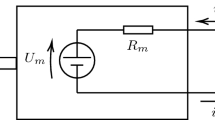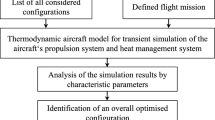Abstract
Electric airplanes powered by fuel cells are a promising alternative for green aviation. However, many technological obstacles still have to be overcome for this type of aircraft to be commercially viable. For example, the relatively low output power capacity of fuel cells still constrains the application of these devices to power heavier aircraft. These limitations make performance optimization an even more important subject. This article presents a novel formulation for the analysis of electric current, fuel and oxidizer consumption of fuel-cell-powered airplanes driven by fixed-pitch propellers. Due to its simplicity, lighter weight and lower cost, the fixed-pitch propeller is widely used on aircraft with small flight speed variation. Also, since the efficiency of this type of propeller is known to vary with airspeed, a dedicated method is necessary. A parametric description of the relevant aircraft systems is developed, and expressions for instantaneous and total consumption are formulated. Optimal conditions for these performance metrics are investigated, and analytical solutions are derived and presented in closed form. The formulation employs a parametric model for the fixed-pitch propeller and eliminates the need to determine the motor and propeller rotation speed. A numerical approach for method validation is used, and simulations are provided to give the reader a quantitative insight into the problem. The results show that the optimal speeds for minimum fuel consumption of fuel-cell-powered aircraft driven by fixed-pitch propellers can be higher than what is predicted by traditional methods. Mathematical proofs are provided to show that this can happen.








Similar content being viewed by others
Data availability
The datasets generated during and/or analyzed during the current study are available from the corresponding author on reasonable request.
Notes
The propeller polar is usually written with the power coefficient \(C_P\) as a function of \(C_T\) but, being an affine function, it can be inverted and employed in the form presented.
Aircraft and systems data kindly provided by the engineering team at CENIC Engineering, in São José dos Campos, Brazil.
Abbreviations
- \(\alpha\) :
-
Angle of attack
- \(\gamma\) :
-
Flight path angle
- V :
-
True airspeed
- T :
-
Propeller thrust
- W :
-
Aircraft weight
- L :
-
Aerodynamic lift
- D :
-
Aerodynamic drag
- \(C_{L}\) :
-
Lift coefficient
- \(C_{D_{0}}\) :
-
Zero lift drag coefficient
- k :
-
Lift-dependent drag constant
- \(\rho\) :
-
Air density
- h :
-
Altitude
- g :
-
Gravitational acceleration
- S :
-
Wing reference area
- \(\eta _{fc}\) :
-
Fuel cell efficiency
- \(\eta _p\) :
-
Propeller efficiency
- \(\eta _m\) :
-
Electric motor efficiency
- \(\eta\) :
-
Propulsion system total efficiency
- \(Q_p\) :
-
Propeller torque
- \(Q_m\) :
-
Electric motor torque
- \(R_{fc}\) :
-
Fuel cell internal resistance
- \(R_m\) :
-
Motor internal resistance
- i :
-
Electric current
- \(i_0\) :
-
Motor no-load current
- F :
-
Faraday constant
- \(K_V\) :
-
Motor speed constant
- \(K_Q\) :
-
Motor torque constant
- \(C_{el }\) :
-
Electric charge
- \({\dot{m}}\) :
-
Instantaneous consumption (mass flow)
- m :
-
Total consumption (mass)
- s :
-
Traveled distance
- \(U_0\) :
-
Fuel cell open-circuit voltage
- \(C_T\) :
-
Propeller thrust coefficient
- \(C_Q\) :
-
Propeller torque coefficient
- n :
-
Propeller rotation frequency
- J :
-
Propeller advance ratio
- \(a_p\) :
-
Propeller polar angular coefficient
- \(b_p\) :
-
Propeller polar independent term
References
Taurus electro motor glider. Pipistrel (2007). Accessed 20 Oct 2022. http://www.pipistrel-aircraft.com/products/gliders/taurus-electro
Airbus SE: Hydrogen fuel cells, explained (2020). Accessed 14 Aug 2022. https://www.airbus.com/en/newsroom/news/2020-10-hydrogen-fuel-cells-explained
Anderson, J.D.: Aircraft Performance and Design, 1st edn. McGraw-Hill, New York (1999)
Anderson, J.D.: Fundamentals of Aerodynamics, 5th edn. McGraw-Hill Education, New York (2010)
Araujo, G., Hepher, T.: Brazil’s Embraer unveils family of green concept planes. Nasdaq News (2021). Accessed 14 Aug 2022. https://www.nasdaq.com/articles/brazils-embraer-unveils-family-of-green-concept-planes
Avanzini, G., de Angelis, E.L., Giulietti, F.: Optimal performance and sizing of a battery-powered aircraft. Aerospace Sci. Technol. 59, 132–144 (2016). https://doi.org/10.1016/j.ast.2016.10.015
Avanzini, G., Giulietti, F.: Maximum Range for Battery-Powered Aircraft. J. Aircraft 50(1), 304–307 (2013). https://doi.org/10.2514/1.C031748
Barufaldi, G.N.: Flight Performance Analysis of Electric Aircraft. Ph.D. thesis, Instituto Tecnológico de Aeronáutica, São José dos Campos, Brazil (2021). Accessed 10 Oct 2022. http://www.bdita.bibl.ita.br/tesesdigitais/77944.pdf
Barufaldi, G.N., Morales, M.A.V., da Silva, R.G.A.: Parametric determination of fuel consumption during cruise flight for fuel cell powered airplanes. J. Braz. Soc. Mech. Sci. Eng. 44(3), 1–10 (2022). https://doi.org/10.1007/s40430-022-03383-4
Borer, N.K., Geuther, S.C., Litherland, B.L., Kohlman, L.: Design and Performance of a Hybrid-Electric Fuel Cell Flight Demonstration Concept. In: AIAA Aviation Forum (2018). https://doi.org/10.2514/6.2018-3357
Brelje, B.J., Martins, J.R.R.A.: Electric, hybrid, and turboelectric fixed-wing aircraft: a review of concepts, models, and design approaches. Prog. Aerosp. Sci. 104, 1–19 (2019). https://doi.org/10.1016/j.paerosci.2018.06.004
DLR: Zero-emission air transport – first flight of four-seat passenger aircraft HY4. Deutsches Zentrum für Luft- und Raumfahrt e.V. (2016). Accessed 08 June 2018. https://www.dlr.de/dlr/en/desktopdefault.aspx/tabid-10081/151_read-19469/#/gallery/24480.
Donateo, T., Ficarella, A., Spedicato, L., Arista, A., Ferraro, M.: A new approach to calculating endurance in electric flight and comparing fuel cells. Appl. Energy 187, 807–819 (2017). https://doi.org/10.1016/j.apenergy.2016.11.100
Drela, M.: First-Order DC Electric Motor Model. MIT Aero & Astro (2007). Accessed 27 Apr 2022. https://web.mit.edu/drela/Public/web/qprop/motor1_theory.pdf
Embraer: Energia. Right for the World Ahead. Embraer Global (2022). Accessed 14 Aug 2022. https://embraer.com/global/en/9280-energia-right-for-the-world-ahead
Federal Aviation Administration: Pilot’s Handbook of Aeronautical Knowledge: FAA-H-8083-25B. Aviation Supplies & Academics, Newcastle (2016)
Garzon, F., Uribe, F.A., Rockward, T., Urdampilleta, I.G., Brosha, E.L.: The impact of hydrogen fuel contaminates on long-term PMFC performance. ECS Trans. 3(1), 695–703 (2006). https://doi.org/10.1149/1.2356190
Geuther, S., Capristan, F.: Feasibility of a Solid Oxide Fuel Cell System Applied to Hybrid-Electric Regional Aircraft. In: AIAA SciTech Forum (2020). https://doi.org/10.2514/6.2020-1500
Gur, O., Rosen, A.: Optimizing electric propulsion systems for unmanned aerial vehicles. J. Aircr. 46(4), 1340–1353 (2009). https://doi.org/10.2514/1.41027
Hepperle, M.: Electric flight - potential and limitations. In: Proceedings of the NATO Science and Technology Organization Meeting, vol. 209 (2012)
Kaptsov, M., Rodrigues, L.: Electric Aircraft Flight Management Systems: Economy Mode and Maximum Endurance. J. Guid. Control. Dyn. 41(1), 285–290 (2018). https://doi.org/10.2514/1.G002806
Kaptsov, M., Rodrigues, L.: Flight management system for hydrogen-powered aircraft in cruise. Aerospace Systems 4(3), 201–208 (2021). https://doi.org/10.1007/s42401-021-00097-8
Kelly, T.J.: Moon Lander - How we developed the Apollo Lunar Module. Smithsonian Books, Washington (2001)
Lange Aviation: The Antares 20E (2003). Accessed 09 June 2020. https://www.lange-aviation.com/en/produkte/antares-20e/antrieb-e/
Lapeña-Rey, N., Mosquera, J., Bataller, E., Ortí, F.: First Fuel-Cell Manned Aircraft. J. Aircr. 47(6), 1825–1835 (2010). https://doi.org/10.2514/1.42234
Litherland, B.L., Borer, N.K., Geuther, S.C.: A Study on the Use of Solid-Oxide Fuel Cells for Increased Power Generation on Small Aircraft. In: AIAA Aviation Forum (2019). https://doi.org/10.2514/6.2019-3564
McDonald, R.A.: Electric Motor Modeling for Conceptual Aircraft Design. In: Proceedings of the 51st Aerospace Sciences Meeting (2013). https://doi.org/10.2514/6.2013-941
Miele, A.: Flight Mechanics: Theory of Flight Paths, 1st edn. Dover Publications, New York (2016)
Mises, R.V.: Theory of Flight, pp. 285–316. Dover Publications, New York (1945)
O’Hayre, R., Cha, S.W., Colella, W., Prinz, F.B.: Fuel Cell Fundamentals, 2nd edn. Wiley, Hoboken (2009)
Pipistrel Aircraft: Velis Electro (2020). https://www.pipistrel-aircraft.com/aircraft/electric-flight/velis-electro-easa-tc/
Raymer, D.P.: Aircraft Design: A Conceptual Approach, 4th edn. AIAA Education Series. American Institute of Aeronautics and Astronautics, Reston, VA (2006)
Salehpour, M.J., Zarenia, O., Hosseini Rostami, S.M., Wang, J., Lim, S.J.: Convex multi-objective optimization for a hybrid fuel cell power system of more electric aircraft. Int Transact Electrical Energy Syst (2020). https://doi.org/10.1002/2050-7038.12427
Schemp-Hirth.: The Arcus-E Sailplane. Schempp-Hirth Flugzeugbau GmbH (2012). https://www.schempp-hirth.com/en/sailplanes/arcus/arcus-e.html. Retrieved 10 Nov 2019
Settele, F., Holzapfel, F., Knoll, A.: The Impact of Peukert-Effect on Optimal Control of a Battery-Electrically Driven Airplane. Aerospace 7(2), 13 (2020). https://doi.org/10.3390/aerospace7020013
Stroman, R.O., Schuette, M.W., Swider-Lyons, K., Rodgers, J.A., Edwards, D.J.: Liquid hydrogen fuel system design and demonstration in a small long endurance air vehicle. Int. J. Hydrogen Energy 39(21), 11279–11290 (2014). https://doi.org/10.1016/j.ijhydene.2014.05.065
Theodorsen, T., Stickle, G.W., Brevoort, M.J.: Characteristics of Six Propellers Including the High-Speed Range. Tech. Rep. No. 594, National Advisory Committee for Aeronautics, Langley, VA (1937)
Author information
Authors and Affiliations
Corresponding author
Ethics declarations
Conflict of interest
The authors are solely responsible for the printed material included in this paper and have no conflict of interest.
Additional information
Publisher's Note
Springer Nature remains neutral with regard to jurisdictional claims in published maps and institutional affiliations.
Supplementary Information
Below is the link to the electronic supplementary material.
Rights and permissions
Springer Nature or its licensor (e.g. a society or other partner) holds exclusive rights to this article under a publishing agreement with the author(s) or other rightsholder(s); author self-archiving of the accepted manuscript version of this article is solely governed by the terms of such publishing agreement and applicable law.
About this article
Cite this article
Barufaldi, G.N., Morales, M.A.V. Minimum fuel consumption of fuel-cell-powered airplanes driven by fixed-pitch propellers. CEAS Aeronaut J 14, 295–309 (2023). https://doi.org/10.1007/s13272-023-00653-2
Received:
Revised:
Accepted:
Published:
Issue Date:
DOI: https://doi.org/10.1007/s13272-023-00653-2




